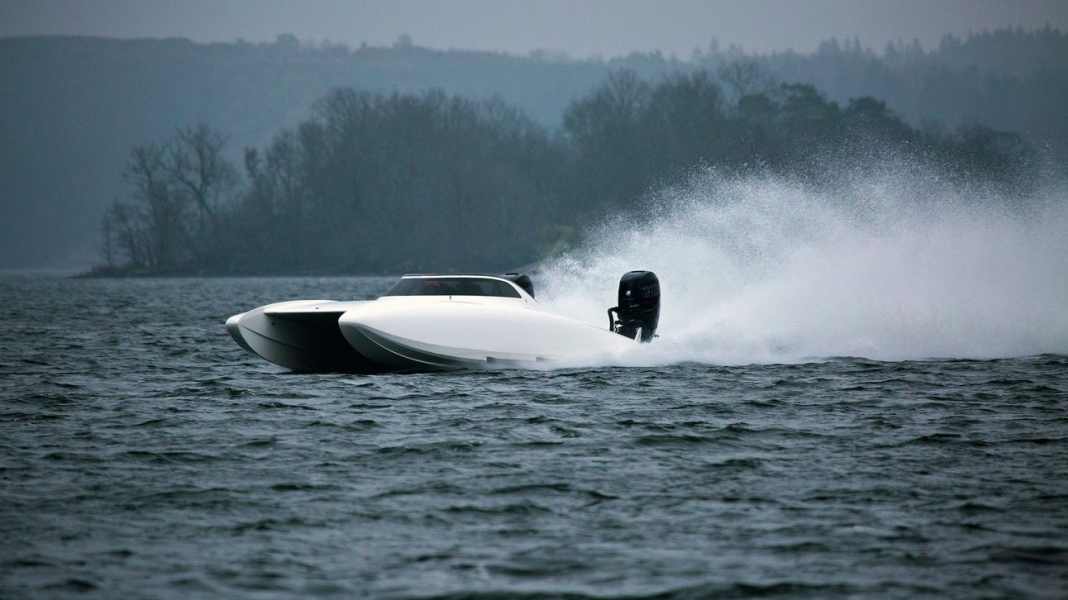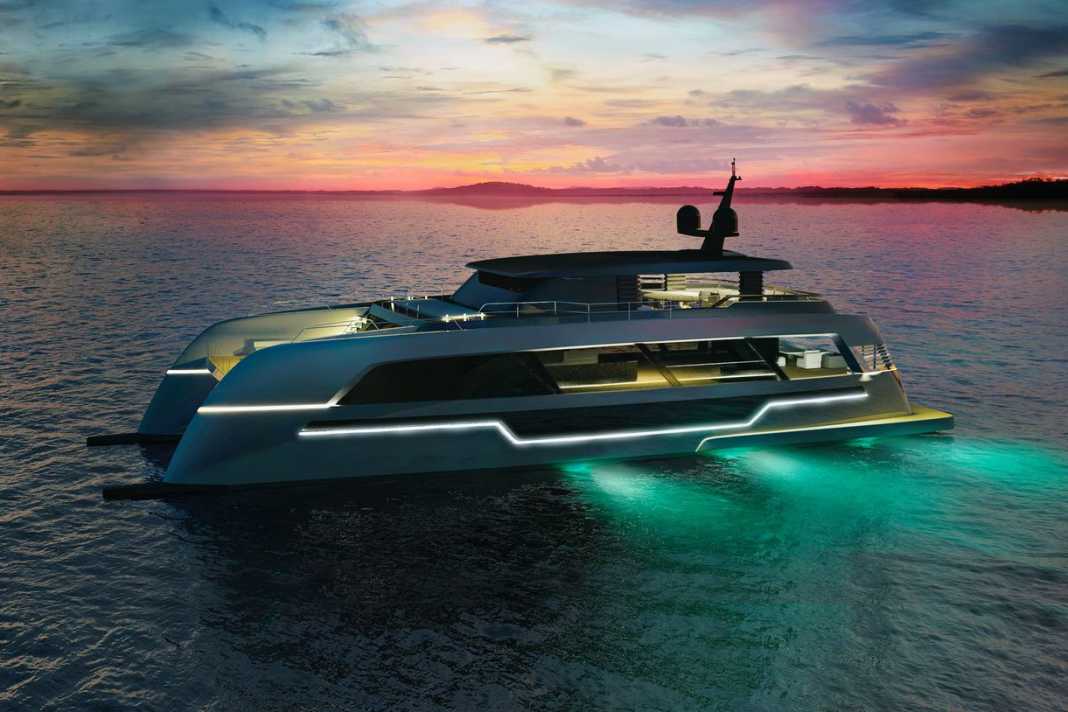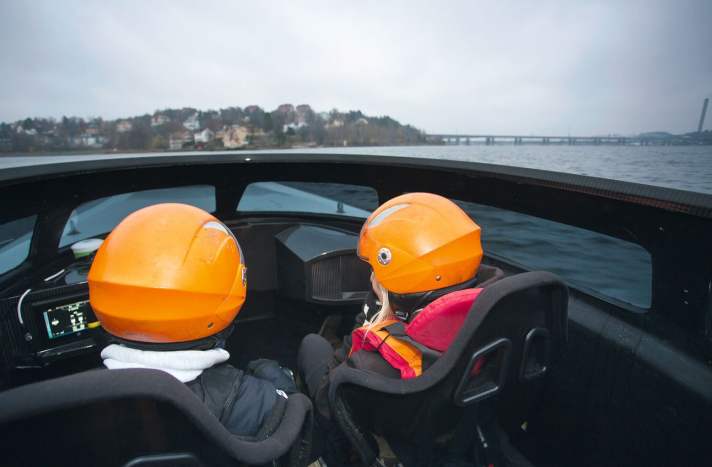Catamarans on test - Take two

Catamarans offer plenty of space, but they also take up a lot of it. Especially in the harbour. And this is much less due to their manoeuvrability than to their dimensions. They literally spread out. The berth problem is almost impossible to solve in our latitudes. Further south, they are simply put on the chain - which is also meant literally.
In other words, Roman Catholic backwards to the pier. Mooring is done with the help of a mooring ring. An important advantage of the catamaran is its low current resistance. This saves fuel and, with the right motorisation, makes it extremely fast. Just how fast is demonstrated by the racing scene, in which double-hulled boats dominate.
Important for normal boat drivers: catamarans, says BOOTE employee Hartmut Brandt, are much faster than conventional monohull boats with favourable energy consumption. That leaves the question of rough water characteristics.
The retired professor from TU Berlin attests to the good sea behaviour of catamarans. Their large width prevents large heeling angles and rolling movements. Disadvantage: At higher speeds, it can get really wet on deck. A prerequisite for good seaworthiness is that the "beams" connecting the decks and hulls provide sufficient clearance to the water surface. So much for Professor Hartmut Brandt.






Away from the race track, catamarans are almost always furnished. Sporty character and handling characteristics play a secondary role. The important thing is space. And there is usually plenty of it. A paradise for charter companies.
Landlords prioritise the number of beds and easy-care fixtures and fittings. Function is in demand, nobody really wants to win a beauty prize. Owner yachts are the exception to the rule. Here, large rooms, exclusive furnishings and comfort are at the top of the wish list. Small compartments, bunk beds and washable plastic are a no-go for this clientele.
The owner wants and gets something special. And that is a modern design, innovative drive technology, the latest navigation and communication electronics, fine woods, fine fabrics and a customised room layout. You can and want to be your own interior designer.
The centrepiece of life on board is often a fully glazed deck saloon, which houses the driving position, comfortable upholstered sofas, a fully equipped galley and a large dining table. In fine weather, you can meet up on the flybridge. This is a must in this category, as is the owner's suite with separate bathroom, dressing table and an XXL-sized bed.
It goes without saying that the guests also sleep comfortably and have their own bathroom. There is plenty of space. There is also space for a dinghy garage or large solar panels which, in combination with the latest battery technology, offer the option of electric propulsion. This may not win any races, but it is good for the environment.
Conclusion: Catamarans can often do more than expected and are therefore quite rightly on course for success.
Test: Hypercat Pleasure
The Swedish Hypercat Pleasure offers amateur racers new opportunities to be fast, safe and soon also ECO-friendly on the road
Modern design, lightweight carbon fibre hull, tested safety cockpit and a speed of more than 100 knots. The key data of the Hypercat Pleasure promise pure adrenalin and set standards in the leisure boat sector.
The reactions from the high-speed scene were not long in coming. Demand is coming from all sides - prospective boat buyers from the USA, China and even the Caribbean have already signalled their interest.
It all started in 2016, when the Swedish racing team Swecat Racing wanted a new offshore racing boat for the team. A boat that would be ideally suited to the new Mercury 400R engines. Instead of just modifying the old racing boat, Swecat Racing designed a completely new boat together with the world-famous designers, Ocke and Ted Mannerfelt. The result is two different models; Hypercat Pleasure and Hypercat Racing.
Both are developed and produced in Sweden. "Pleasure" is intended for the leisure market and "normal riders" and is set to go into series production from the start of 2019. "Race" is suitable for offshore racing and will take part in the XCAT series races from 2019. The first two Pleasure boats were sold before they were built.
"This allowed the project to gain momentum and the financing was on a solid footing right from the start," says Niklas Sjöö, owner and managing director of Swecat Racing.
But how does a high-tech racer like this feel for recreational pilots? I am the first person outside the actual racing team to be trusted by the shipyard to test the new powerhouse. I'm a little nervous and check that the lifejacket fits properly, put the oversized helmet over my head and take a seat in the low, customised driver's seat.

It is early winter in Stockholm and the persistent rain forms small rivulets on the narrow windscreen. As soon as I start the twin Mercury 400R engines and pick up speed, the rainwater is effectively pushed aside by the wind pressure and visibility is no longer impaired.
I start with a few slow laps to familiarise myself with the boat and get a feel for how it handles. The Hypercat is surprisingly easy to drive and the risk of underestimating the speed is high. I accelerate slowly to cruising speed and the instruments stabilise at 70 knots. For me, however, this feels more like 25 knots in a normal sports boat. The handling is safe and comfortable.
The boat reacts directly, but without any nervousness, to the smallest steering commands. I am impressed by how safe and stable the catamaran hull is on its self-generated air cushions as it glides calmly and completely undramatically across the stern sea of a passenger ferry. The boat's width of around three metres ensures a stable position in the water and the much-cited "good feeling" for the driver.
The fuel consumption is also impressive. At a speed of 65-70 knots, we only consume around 1.5 l/sm, which is less than some sports boats of the same size with a monohull, and the boat's range is correspondingly long.
It's one thing to go straight ahead extremely quickly. But keeping the boat safely under control at high speed and in waves, even when cornering, is a challenge, I realise. My nervousness subsides after the first fast bends. It soon becomes clear that the designers had already focussed on the safest and easiest handling possible when designing the hull.

To provide further reassurance, Swecat offers potential buyers a two-day sailing course in Stockholm to teach owners how to handle the boat in all situations.
In addition, the speed is initially restricted to a maximum of 80 knots. Only when the driver has successfully demonstrated his driving skills is the limit lifted and the maximum speed of 100 knots permitted.
The design of an open cockpit presented a number of new challenges. Especially when offering comfortable and safe seating for four people. Only after a special safety cell was installed around the cockpit and approved by the authorities was the team satisfied.
In addition, wind tunnel tests were carried out with the aim of minimising the overall air resistance and, above all, the wind turbulence in the boat for the passengers.
Swecat Racing also sees the Hypercat as the ideal test platform for trialling different engines with new drive alternatives. "We are closely following the development of all new boat drives, including the electric variants. We have put a lot of effort into research and development in the selection and calculation of the latest generation of battery cells to make our catamaran suitable for innovative drives. Together with newly developed electric motors, it is now possible to achieve a really high output that is not inferior to combustion engines in terms of performance," says Niklas Sjöö.
For the future, Swecat will also be looking for new partners with whom they would like to develop the next generation, the so-called "Hypercat Electric". "We want to establish a new international e-offshore racing class under the leadership of the U.I.M.
In this segment, we will be able to offer a new competitive electric boat for e-offshore racing in the future. It goes without saying that this boat will also be available in a pleasure boat version. Work is also already underway on a closed version of the boat.

